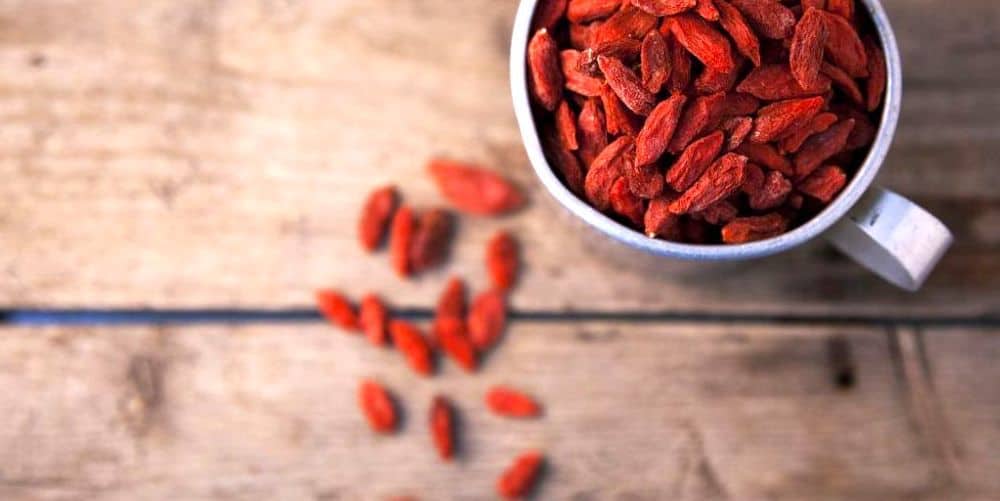BENEFITS OF GOJI BERRIES
✓ Source of antioxidants
✓ Boost the immune system
✓ Anti-fatigue
✓ Detoxifying
What is the goji berry?
Grown in China for at least two thousand years, it is also known as the goji or wolfberry (Lycium Barbarum and Lycium Chinense). The name “goji” was created in 1973 by an American botanist, derived from the Chinese word for these fruits, gǒuqǐzǐ.
Goji comes in the form of elongated, slightly sweet red berries that grow at altitudes on shrubs which can reach up to 3 meters high. They belong to the Solanaceae family, just like tomatoes, eggplants, or potatoes.
Their bright color has been brightening up our granolas, smoothies, and other healthy desserts for a few years now, but they have been known in China, the Himalayan regions, and Mongolia for millennia.
Today, 80% of the world’s production comes from NingXia in northern China, and they are increasingly found in France in small-scale plantations.

They are among the main remedies of traditional Chinese medicine, as food and tonic for the liver and kidneys. In Chinese pharmacopoeia, they are considered as carriers of eternal youth, as their antioxidant properties are believed to prevent the aging of neurological functions, vision, skin, and support the immune system.
They are believed to strengthen the Qi, our vital energy. In Tibet, this fruit is nicknamed “smile berry.” Goji berries are usually consumed dried, but they are also available as juice, powder, or capsules, and more rarely raw.
Goji is a remarkable source of nutrients. These berries contain more beta-carotene than carrots, more protein than wheat, and 1.5 times more calcium than milk.
The richness in nutrients and active principles of goji berries could be explained by the fact that they originally grew at altitude in rather hostile regions, subject to intense droughts and frosts.
Their benefits have been praised for millennia in Asia and more recently in the West, where studies on this subject are still not well developed.
Nutritional composition
- Proteins: 18 amino acids including 8 essential ones (notably tryptophan and isoleucine)
- 21 minerals and trace elements including iron, zinc, copper, selenium, phosphorus, calcium, germanium
- Antioxidants: carotenoids including beta-carotene
- Vitamins: B1, B2, B6, C and E
- Beta-sitosterol
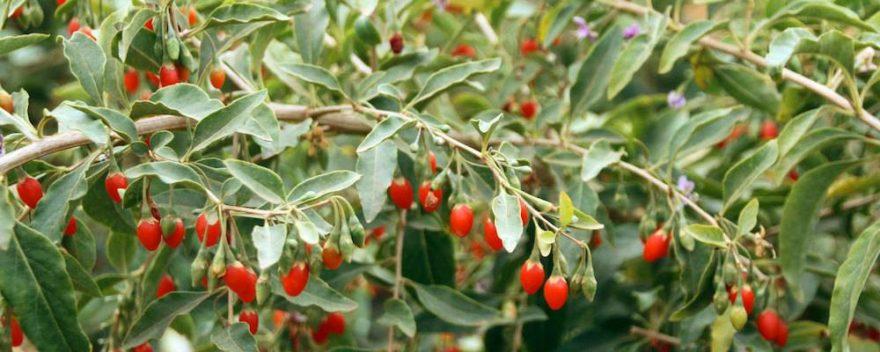
Benefits of goji berries
🥝 Source of antioxidants
Goji berries have remarkable antioxidant properties mainly thanks to the carotenoids they contain, thus helping to fight free radicals, responsible for cellular aging.
They are ranked among the top fruits richest in antioxidants, with an ORAC index (Oxygen Radical Absorbance Capacity) of 36,000 per liter. This ranking is established by the US government health institute.
These antioxidants help fight oxidative stress and promote collagen production, acting as an anti-aging agent for the skin.
They are also believed to promote concentration and memory, and combat age-related neurodegenerative diseases.
This preliminary study conducted by the University of Hong Kong demonstrated that goji berry extract protected rat neurons from a protein present in Alzheimer’s disease.
🛡 Boost the immune system
Goji berries have a high content of vitamins B1, B2, B6, C, and E. These contribute particularly to boosting our immune system.
They also contain polysaccharides that help regulate and stimulate it. They are particularly believed to prevent flu, colds, and treat urinary infections.
⚡️Anti-fatigue
Like camu camu and acerola, goji berries contain more vitamin C than oranges, acting as an anti-fatigue agent and a general stimulant. Vitamin C also helps with better iron absorption.
They are also particularly rich in iron, which promotes the development of red blood cells and reduces the effects of fatigue. This high iron content is also one of the reasons they are recommended for people following a vegetarian or vegan diet.
Their high content of trace elements helps to compensate for certain dietary deficiencies and boost our energy.
💎 Detoxifying
Goji berries are a prime detox food because they help eliminate toxins more easily and protect the liver.
They help improve liver function and repair liver damage, notably those caused by excessive alcohol consumption. Note, it is not a miracle cure; the ideal way to have a healthy liver is to maintain a balanced and healthy diet.
This study by Chongqing University of Medical Sciences in China showed the benefits of consuming berries on rats with alcohol-induced hepatitis.
🍳 Anti-cholesterol and help with weight loss
Goji berries help fight cholesterol thanks to the beta-sitosterol they contain. This substance is a plant-derived similar to cholesterol, which limits its penetration into the body.
They have hypoglycemic properties and thus help lower blood sugar and blood pressure.
They are true nutritional shots with a sweet taste and thus a good “snack” option with low sugar and calorie content compared to other dried fruits.
They fit perfectly into a weight loss diet, especially since their high protein content enhances the feeling of fullness.
Also read Can you really lose weight with goji berries?
👁 Protect the eyes
Goji berries are loaded with zeaxanthin, a powerful antioxidant that gives them their beautiful reddish-orange color. This latter acts directly on the retina, protecting its cells from degeneration.
They contain 5 carotenoids including beta-carotene, pro-vitamin A, which promote visual acuity.
This study conducted by the Nestlé Product Technology Center in Switzerland on subjects aged 65 to 70 years demonstrates that daily consumption of goji berries for 90 days helps combat macular degeneration and cataracts.
🔬 Potentially anti-cancer
Goji berries may help prevent the appearance of cancerous cells due to their high content of vitamin C and antioxidants (notably zeaxanthin and beta-carotene).
This study from the Second Military Medical University of Shanghai conducted on 75 patients with various advanced-stage cancers attests that the intake of goji berries combined with an anti-cancer drug has beneficial effects and causes cancer cells to regress.
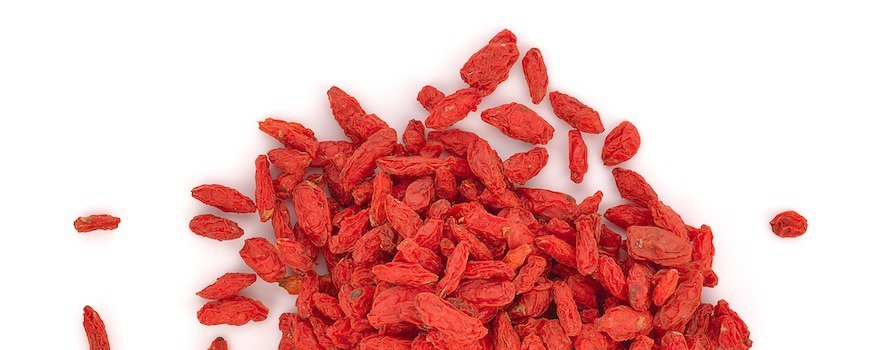
How to consume goji berries?
Dried goji berries
Nowadays, most supermarkets sell dried goji berries, either in the dried fruit aisle or in the organic section. Organic stores, dietary shops, and e-commerce sites are well-stocked with them, and they can also be bought in bulk.
They are harvested when ripe and, ideally, sun-dried traditionally (these are the most tender), by cooking, or through a mechanical dehydration process.
It’s the most practical way to consume them, either plain, as you would enjoy dried fruits, or in savory or sweet recipes.
They can accompany main courses with chicken or fish, like red fruit smoothies, granola, cakes, yogurts. In any case, they will add a lovely color to your dishes!
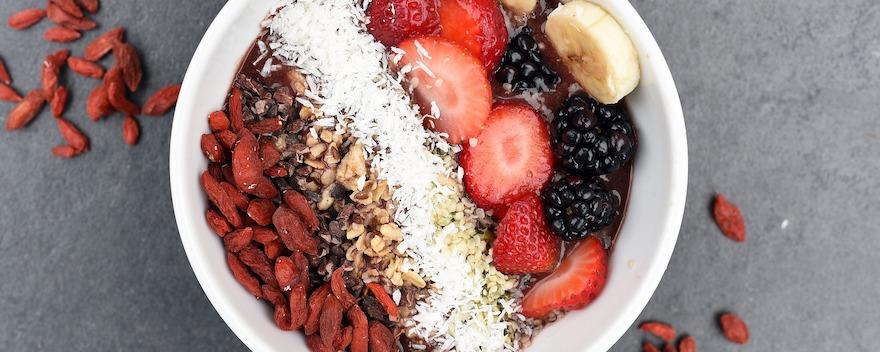
Goji berries in juice
Another interesting way to consume goji berries is in juice form. These juices are often made in Europe, from berries imported from Asia.
Their composition varies, they are often mostly composed of water and other fruits, so it’s important to check their high content of goji berries to make the most of their effects. Be careful, pure juice might be quite acidic, it is advisable to mix it with water.
Their price and nutritional value, due to multiple processing steps, are often less appealing than dried berries, but they are easy to consume and to mix with other juices, or coconut water.
Goji berries also come in tablets, capsules and in powder.
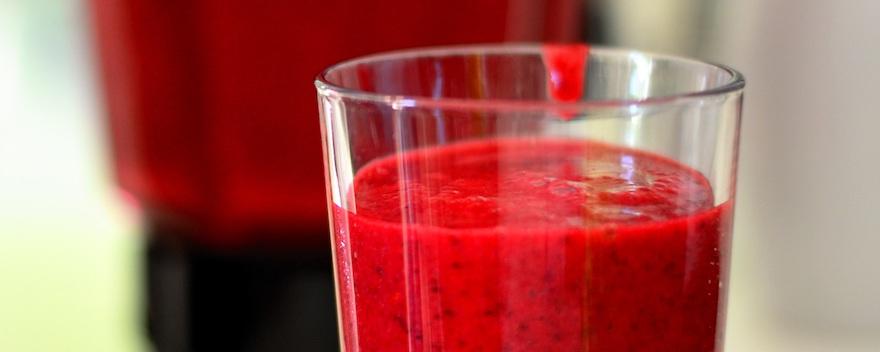
Can goji berries be dangerous?
These berries are not unanimously supported by nutrition experts and several controversies are ongoing. On one hand, they may not be more beneficial than other red fruits we are used to eating: raspberries, blueberries…
Also read Are goji berries dangerous?
On the other hand, some producers irradiate them to better preserve them during long journeys, a process that limits their nutritional richness, and is suspected of being detrimental to the body in the long term.
Moreover, following a study by the magazine Test Achat, the Belgian cousin of 60 Millions de consommateurs, goji berries have recently faced bad press. Out of 15 product references, 10 contained a lot of pesticides, including 3 certified organic brands.
The taste of goji berries
Goji berries are slightly sweet and tangy, somewhat like traditional berries. Their taste varies depending on the producer and manufacturing method. They pair well with both salty and sweet dishes!
Sustainable consumption: favor organic, fair trade, and local goji berries
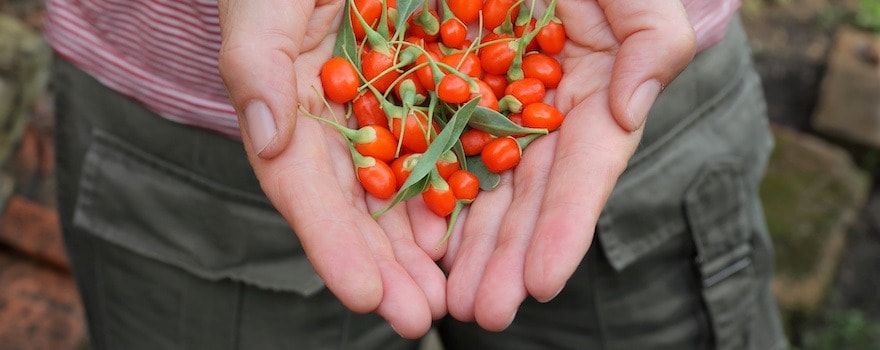
✓ Obviously, organic goji berries are better in terms of nutrients, for your health in general, and for the planet. To ensure they are organic, one must rely on labels, and their traceability should be clear. Small farms should be prioritized, whether in China, Tibet, or Mongolia. Fair trade goji berries should be favored to ensure a better income for their producers and growers.
✓ One way to ensure optimal growing quality is also to source from small French producers, in Midi, in Beaujolais, or in Alsace, for example. French goji berries are more expensive, but since they are local, their carbon footprint is significantly lower than those from Asia.
✓ A final option is to grow them yourself! You just need to get some seeds or a plant and follow the steps indicated by your merchant.
Dosage
Their consumption is very easy, and their good sweet taste might tempt unlimited consumption. What dosage should be adopted?
⚖️ For an anti-fatigue treatment: 6 to 12g per day (about 2 tablespoons) for three months.
💊Capsules of goji extract (about 600 mg): 2 to 3 capsules per day to start, then increase the amounts if necessary.
🥄 In a therapeutic context: up to 80 dried berries per day.
Contraindications and side effects
There is no major contraindication to the consumption of goji berries. However, they are not recommended for pregnant or breastfeeding women, children, and people on anticoagulant therapy.
At the beginning of a treatment, side effects such as nausea, stomach aches, and headaches may occur. They can mean the detox is working, but it is better to reduce the daily dose and then gradually increase it again.
History, culture, and market of goji berries
Traditional Chinese medicine prescribes goji berries in the treatment of various pathologies. They are notably used by the elderly to strengthen the Yin, the inverse force of Yang.
They are believed to especially strengthen Qi, our vital energy, and promote longevity in good health.
They are consumed raw or in decoction, to treat liver and kidney problems. It is said they lubricate the lungs.
They originally come from regions where the climate is very harsh, with temperature variations ranging from -20°C to 20°C, in Inner Mongolia, Tibet, and the Chinese region of NingXia. This region, consisting of high plateaus over 2000 meters altitude, is the world’s main producer of goji berries with 80% of production.
Sources and scientific studies
Yu MS, Leung SK, Lai SW, Che CM, Zee SY, So KF, Yuen WH, Chang RC, 2005. Neuroprotective effects of anti-aging oriental medicine Lycium barbarum against beta-amyloid peptide neurotoxicity.
Gu S, Wang PL, Jiang R, 2007. [A study on the preventive effect of Lycium barbarum polysaccharide on the development of alcoholic fatty liver in rats and its possible mechanisms].
Bucheli P, Vidal K, Shen L, Gu Z, Zhang C, Miller LE, Wang J, 2011. Goji berry effects on macular characteristics and plasma antioxidant levels.
Cao GW, Yang WG, Du P,1994. [Observation of the effects of LAK/IL-2 therapy combining with Lycium barbarum polysaccharides in the treatment of 75 cancer patients].


